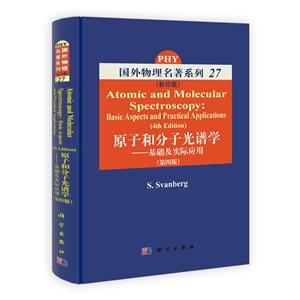原子和分子光谱学
内容简介
[
A wide-ranging review of modem spectroscopic techniques such as X-ray, photoelectron,optical and laser spectroscopy, and radiofrequency and microwave techniques.On the fundamental side the book focuses on physical principles and the impact of spectroscopy on our understanding of the building blocks of matter, while in the area of applications particular attention is given to those in chemical analysis,photochemistry, surface characterisation, environmental and medical diagnostics, remote sensing and astrophyscis.The Fourth Edition also provides the reader with an update on laser cooling and trapping, Bose- Einstein condensation, ultra-fast spectroscopy, highpower laser/matter interaction, satellitebased astronomy and spectroscopic aspects of laser medicine.
]
目录
1.Introduction2.Atomic Structure2.1 One-Electron Systems2.2 Alkali Atoms2.3 Magnetic Effects2.3.1 Precessional Motion2.3.2 Spin-Orbit Interaction2.4 General Many-Electron Systems2.5 The Influence of External Fields2.5.1 Magnetic Fields2.5.2 Electric Fields2.6 Hyperfine Structure2.6.1 Magnetic Hyperfine Structure2.6.2 Electric Hyperfine Structure2.7 The Influence of External Fields (hfs)2.8 Isotopic Shifts3.Molecular Structure3.1 Electronic Levels3.2 Rotational Energy3.3 Vibrational Energy3.4 Polyatomic Molecules3.5 Clusters3.6 Other Molecular Structures4.Radiation and Scattering Processes4.1 Resonance Radiation4.2 Spectra Generated by Dipole Transitions4.2.1 Atoms4.2.2 Molecules4.3 Rayleigh and Raman Scattering4.4 Raman Spectra4.4.1 Vibrational Raman Spectra4.4.2 Rotational Raman Spectra4.4.3 Vibrational-Rotational Raman Spectra4.5 Mie Scattering4.6 Atmospheric Scattering Phenomena4.7 Comparison Between Different Radiation and Scattering Processes4.8 Collision-Induced Processes5.Spectroscopy of Inner Electrons5.1 X-Ray Spectroscopy5.1.1 X-Ray Emission Spectroscopy5.1.2 X-Ray Absorption Spectroscopy5.1.3 X-Ray Imaging Applications5.2 Photoelectron Spectroscopy5.2.1 XPS Techniques and Results5.2.2 Chemical Shifts5.3 Auger Electron Spectroscopy6.Optical Spectroscopy6.1 Light Sources6.1.1 Line Light Sources6.1.2 Continuum Light Sources6.1.3 Synchrotron Radiation6.1.4 Natural Radiation’Sources6.2 Spectral Resolution Instruments6.2.1 Prism Spectrometers6.2.2 Grating Spectrometers6.2.3 The Fabry-Perot Interferometer6.2.4 The Fourier Transform Spectrometer6.3 Detectors6.4 Optical Components and Materials6.4.1 Interference Filters and Mirrors6.4.2 Absorption Filters6.4.3 Polarizers6.4.4 Optical Materials6.4.5 Influence of the Transmission Medium6.5 Optical Methods of Chemical Analysis6.5.1 The Beer-Lambert Law6.5.2 Atomic Absorption/Emission Spectrophotometry6.5.3 Burners, Flames, Sample Preparation and Measurements6.5.4 Modified Methods of Atomization6.5.5 Multi-Element Analysis6.5.6 Molecular Spectrophotometry6.5.7 Raman Spectroscopy6.6 Optical Remote Sensing6.6.1 Atmospheric Monitoring with Passive Techniques6.6.2 Land and Water Measurements with Passive Techniques6.7 Astrophysical Spectroscopy7.Radio-Frequency Spectroscopy7.1 Resonance Methods7.1.1 Magnetic Resonance7.1.2 Atomic-Beam Magnetic Resonance7.1.3 Optical Pumping7.1.4 Optical Double Resonance7.1.5 Level-Crossing Spectroscopy7.1.6 Resonance Methods for Liquids and Solids7.2 Microwave Radiometry7.3 Radio Astronomy8.Lasers8.1 Basic Principles8.2 Coherence8.3 Resonators and Mode Structure8.4 Fixed-Frequency Lasers8.4.1 The Ruby Laser8.4.2 Four-Level Lasers8.4.3 Pulsed Gas Lasers8.4.4 The He-Ne Laser8.4.5 Gaseous Ion Lasers8.5 Tunable Lasers8.5.1 Dye Lasers8.5.2 ColouroCentre Lasers8.5.3 Tunable Solid-State Lasers8.5.4 Tunable CO2 Lasers8.5.5 Semiconductor Lasers8.6 Nonlinear Optical Phenomena8.7 Ultra-short and Ultra-high-Power Laser Pulse Generation8.7.1 Short-Pulse Generation by Mode-Locking8.7.2 Generation of Ultra-high Power Pulses9.Laser Spectroscopy9.1 Basic Principles9.1.1 Comparison Between Conventional Light Sources and Lasers9.1.2 Saturation9.1.3 Excitation Methods9.1.4 Detection Methods9.1.5 Laser Wavelength Setting9.2 Doppler-Limited Techniques9.2.1 Absorption Measurements9.2.2 Intracavity Absorption Measurements9.2.3 Absorption Measurements on Excited States9.2.4 Level Labelling9.2.5 Two-Photon Absorption Measurements9.2.6 Opto-Galvanic Spectroscopy9.2.7 Single-Atom and Single-Molecule Detection9.2.8 Opto-Acoustic Spectroscopy9.3 Optical Double-Resonance and Level-Crossing Experiments with Laser Excitation9.4 Time-Resolved Atomic and Molecular Spectroscopy9.4.1 Generation of Short Optical Pulses9.4.2 Measurement Techniques for Optical Transients9.4.3 Background to Lifetime Measurements9.4.4 Survey of Methods of Measurement for Radiative Properties9.4.5 Quantum-Beat Spectroscopy9.5 Ultrafast Spectroscopy9.5.1 Ultrafast Measurement Techniques9.5.2 Molecular Reaction Dynamics (Femtochemistry)9.5.3 Coherent Control9.6 High-Power Laser Experiments9.6.1 Above Threshold Ionization (ATI)9.6.2 High Harmonic Generation9.6.3 X-Ray Laser Pumping9.6.4 Broadband X-Ray Generation9.6.5 Relativistic Effects and Laser Accelerators9.6.6 Laser-Nuclear Interactions and Laser-Driven Fusion9.7 High-Resolution Laser Spectroscopy9.7.1 Spectroscopy on Collimated Atomic and Ionic Beams9.7.2 Saturation Spectroscopy and Related Techniques9.7.3 Doppler-Free Two-Photon Absorption9.8 Cooling and Trapping of Ions and Atoms9.8.1 Introduction9.8.2 Ion Traps9.8.3 Basic Laser Cooling in Traps9.8.4 Trapped Ion Spectroscopy9.8.5 Atom Cooling and Trapping9.8.6 Sub-Recoil Cooling9.8.7 Atom Optics9.8.8 Bose-Einstein Condensation and “Atom Lasers”9.8.9 Ultracold Fermionic Gases10.Laser-Spectroscopic Applications10.1 Diagnostics of Combustion Processes10.1.1 Background10.1.2 Laser-Induced Fluorescence and Related Techniques10.1.3 Raman Spectroscopy10.1.4 Coherent Anti-Stokes Raman Scattering10.1.5 Velocity Measurements10.2 Laser Remote Sensing of the Atmosphere10.2.1 Optical Heterodyne Detection10.2.2 Long-Path Absorption Techniques10.2.3 Lidar Techniques10.3 Laser-Induced Fluorescence and Raman Spectroscopy in Liquids and Solids10.3.1 Hydrospheric Remote Sensing10.3.2 Vegetation Monitoring10.3.3 Monitoring of Surface Layers10.4 Laser-Induced Chemical Processes10.4.1 Laser-Induced Chemistry10.4.2 Laser Isotope Separation10.5 Spectroscopic Aspects of Lasers in Medicine10.5.1 Thermal Interaction of Laser Light with Tissue10.5.2 Photodynamic Tumour Therapy10.5.3 Tissue Diagnostics with Laser-Induced Fluorescence10.5.4 Scattering Spectroscopy and Tissue TransilluminationQuestions and ExercisesReferencesIndex
封面

书名:原子和分子光谱学
作者:–
页数:588
定价:¥198.0
出版社:科学出版社
出版日期:2016-01-01
ISBN:9787030313386
PDF电子书大小:57MB 高清扫描完整版
